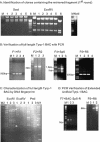Combination of overlapping bacterial artificial chromosomes by a two-step recombinogenic engineering method
- PMID: 12888533
- PMCID: PMC169968
- DOI: 10.1093/nar/gng081
Combination of overlapping bacterial artificial chromosomes by a two-step recombinogenic engineering method
Abstract
Recombinogenic engineering or recombineering is a powerful new method to engineer DNA without the need for restriction enzymes or ligases. We report here a general method for using recombineering to combine overlapping bacterial artificial chromosomes (BACs) to build larger, unified BACs. In order to test the feasibility of using recombineering to combine two large DNA fragments (>20 kb), we constructed a unified BAC containing the full-length tyrosinase-related protein-1 (Tyrp-1) gene from two library-derived BACs, one containing the 5' regulatory elements and the other containing the 3' coding exons. This was achieved using a two-step homologous recombination method enabled by the bacteriophage lambda Red proteins. In the first step, retrieval, a large DNA fragment (approximately 22 kb) was retrieved from one of the original BACs. In the second step, recombination, the retrieved DNA fragment was inserted into the second original BAC to form the unified BAC containing all the desired Tyrp-1 sequence. To further demonstrate the general applicability of our approach, an additional DNA fragment (approximately 20 kb) was inserted into the unified BAC downstream of the coding region. This method should prove very useful for enabling BAC manipulation in a variety of scenarios.
Figures



Similar articles
-
A general method to modify BACs to generate large recombinant DNA fragments.Mol Biotechnol. 2005 Nov;31(3):181-6. doi: 10.1385/MB:31:3:181. Mol Biotechnol. 2005. PMID: 16230767
-
A highly efficient Escherichia coli-based chromosome engineering system adapted for recombinogenic targeting and subcloning of BAC DNA.Genomics. 2001 Apr 1;73(1):56-65. doi: 10.1006/geno.2000.6451. Genomics. 2001. PMID: 11352566
-
Transgene Recombineering in Bacterial Artificial Chromosomes.Methods Mol Biol. 2019;1874:43-69. doi: 10.1007/978-1-4939-8831-0_3. Methods Mol Biol. 2019. PMID: 30353507
-
Bacterial artificial chromosome mutagenesis using recombineering.J Biomed Biotechnol. 2011;2011:971296. doi: 10.1155/2011/971296. Epub 2010 Dec 9. J Biomed Biotechnol. 2011. PMID: 21197472 Free PMC article. Review.
-
Recombineering: a powerful new tool for mouse functional genomics.Nat Rev Genet. 2001 Oct;2(10):769-79. doi: 10.1038/35093556. Nat Rev Genet. 2001. PMID: 11584293 Review.
Cited by
-
Back to BAC: the use of infectious clone technologies for viral mutagenesis.Viruses. 2012 Feb;4(2):211-35. doi: 10.3390/v4020211. Epub 2012 Feb 3. Viruses. 2012. PMID: 22470833 Free PMC article. Review.
-
Assisted large fragment insertion by Red/ET-recombination (ALFIRE)--an alternative and enhanced method for large fragment recombineering.Nucleic Acids Res. 2007;35(10):e78. doi: 10.1093/nar/gkm250. Epub 2007 May 21. Nucleic Acids Res. 2007. PMID: 17517785 Free PMC article.
-
Defining the functional boundaries of the Gata2 locus by rescue with a linked bacterial artificial chromosome transgene.J Biol Chem. 2008 Apr 4;283(14):8976-83. doi: 10.1074/jbc.M709364200. Epub 2008 Jan 21. J Biol Chem. 2008. PMID: 18211891 Free PMC article.
-
CFTR expression from a BAC carrying the complete human gene and associated regulatory elements.J Cell Mol Med. 2009 Sep;13(9A):2938-48. doi: 10.1111/j.1582-4934.2008.00433.x. Epub 2008 Jul 24. J Cell Mol Med. 2009. PMID: 18657227 Free PMC article.
-
A method for generating precise gene deletions and insertions in Escherichia coli.World J Microbiol Biotechnol. 2010 Jul;26(7):1323-9. doi: 10.1007/s11274-009-0305-y. Epub 2010 Jan 8. World J Microbiol Biotechnol. 2010. PMID: 24026937
References
-
- Copeland N.G., Jenkins,N.A. and Court,D.L. (2001) Recombineering: a powerful new tool for mouse functional genomics. Nature Rev. Genet., 2, 769–779. - PubMed
-
- Muyrers J.P., Zhang,Y. and Stewart,A.F. (2001) Techniques: recombinogenic engineering—new options for cloning and manipulating DNA. Trends Biochem. Sci., 26, 325–331. - PubMed
-
- Zhang Y., Buchholz,F., Muyrers,J.P.P. and Stewart,A.F. (1998) A new logic for DNA engineering using recombination in Escherichia coli. Nature Genet., 20, 123–128. - PubMed
Publication types
MeSH terms
Substances
LinkOut - more resources
Full Text Sources
Other Literature Sources
Research Materials

